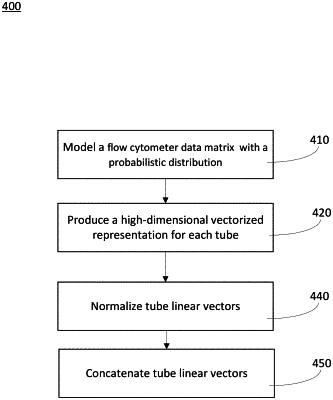| CPC G01N 15/1459 (2013.01) [G01N 15/14 (2013.01); G01N 33/574 (2013.01); G06F 18/2115 (2023.01); G06N 20/10 (2019.01); G16B 50/30 (2019.02); G01N 2015/1488 (2013.01)] | 19 Claims |

|
1. A system comprising:
at least one processor operatively coupled with a datastore, the at least one processor configured to:
receive, from a flow cytometer that is designed to measure multiple parameters, a flow cytometry data matrix that characterizes a tube,
wherein the flow cytometry data matrix includes values that are generated by the flow cytometer via analysis of scattering of light by particles in the tube,
wherein each of the values characterizes a different one of the particles, and
wherein a sample is comprised of a plurality of tubes;
convert the flow cytometry data matrix into a tube high-dimensional vector,
wherein the tube high-dimensional vector is a tube-level feature vector that concatenates the multiple parameters measured by the flow cytometer;
produce a sample high-dimensional vector that comprises a concatenation of a plurality of tube high-dimensional vectors associated with the sample;
assemble a training data set comprising a plurality of sample high-dimensional vectors;
receive, from the datastore, outcome information comprising respective labels associated with each sample high-dimensional vector of the plurality of sample high-dimensional vectors; and
train a classifier based on the training data set and the outcome information.
|